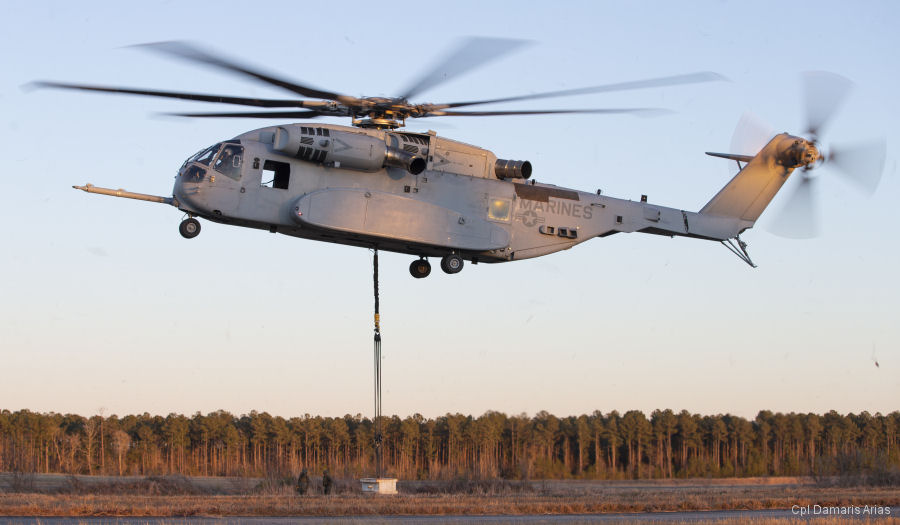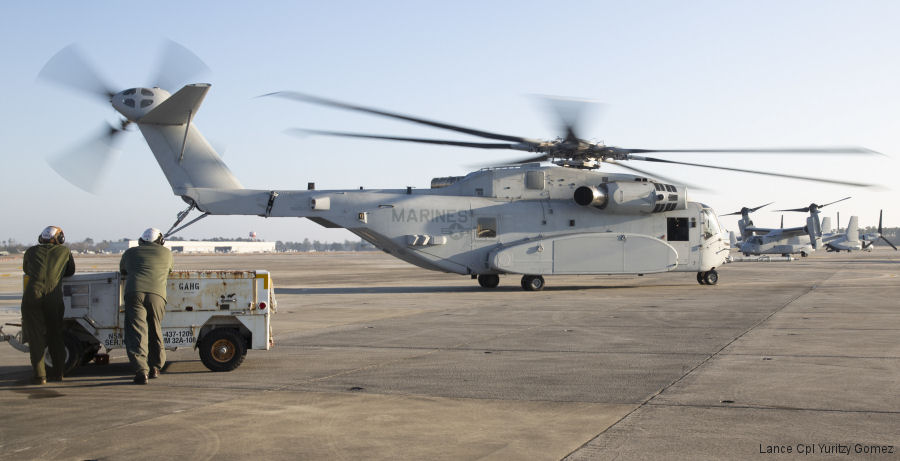
Marine Corps Col. Jack Perrin, the heavy lift helicopter program manager at Naval Air Systems Command, said that Marines from Marine Operational Test and Evaluation Squadron (VMX) 1 began flying the CH-53K King Stallion in January, marking the first time fleet Marines have flown the aircraft.
Until then, only pilots in the test team – professional test pilots hired by the Marine Corps and contractor Sikorsky, as well as those in Air Test and Evaluation Squadron (HX) 21 – had flown the helo.
Since the first fleet flight in mid-January, the pilots have conducted more than 25 hours of flights in the helicopter, in addition to training in the classroom and a simulator.
By this summer, VMX-1 will have trained enough pilots and maintainers to take a four-helicopter detachment out for initial operational test and evaluation (IOT&E). If IOT&E is successful, the Marine Corps should declare IOC soon after. The service hopes to send the new helicopter, which replaces the legacy CH-53E Super Stallion, out for its first deployment in 2023 or 2024.
Perrin said Marines from the squadron are also maintaining the aircraft, and “so far we haven’t missed a single sortie or been late for a sortie due to any maintenance reasons whatsoever.” A major maintenance inspection was conducted at the 25-hour mark and went well, and the Marines have since resumed flying the helicopter.
Perrin spoke about the new helo today during an International Military Helicopter conference hosted by Defence IQ.
Future high-end distributed operations
Between the helo’s greater lift and endurance capabilities than the legacy aircraft, plus the fly-by-wire system reduces the burden on the pilots and the digital interoperability with the rest of the fleet, Perrin said the CH-53K will be a powerful player in future high-end, distributed operations.
He noted that helicopter pilots today can’t just focus on the stick and rudder to fly their aircraft; they need to be able to observe their environment and share information with other aircraft and ships to help fill out the fleet’s understanding of the battlespace. While CH-53K is the best in the world at the heavy-lift mission, he said, “what it brings is that digital interoperability to that battlespace.”
Part of what frees up the pilot to take in more of his or her surroundings is the fly-by-wire capability.
Perrin showed a video that included comments from several VMX-1 Marines, including Lt. Col. Lucas Frank, the VMX-1 CH-53E/K detachment officer in charge.
“It enables you to do things that you would have to be constantly working hard to achieve and working hard to monitor in the 53E, whereas in the Kilo it has a lot of computer systems that will take over for you, it will augment you, and they will enable you to do things like landing in reduced visibility with very little effort that you would not be able to do in the Echo,” Frank said.
Perrin later said that fly-by-wire contributes to the helicopter being classified as an all-weather aircraft.
“The biggest threat is the threat that is the environment and where the pilots have to put that aircraft in the environment – i.e., we make mistakes because of the environment that we’re in, and we have problems, whether it’s degraded visual environment, coming into the ship,” he said.
“With that fly by wire system and the amount of stability that the aircraft has, it really has eliminated a lot of that issue associated with it, and we are really seeing an aircraft that’s really going to increase our safety by reducing that threat of mistakes by the pilot because of that reduced workload.”
Following shipboard compatibility testing last June, the aircraft and test team went to Yuma, Ariz., for degraded visibility testing from July through September. During those tests, the Marines created certain brown-out and other conditions with certain types of dirt that would create the toughest flying and hovering conditions for the pilots. Perrin said the pilots were able to fly in, hover, and pick up external loads with great stability and reduced pilot workload thanks to the fly-by-wire system.
The system also came into play in aerial refueling testing last spring, ahead of the shipboard testing. The test team conducted day and night refuelings, including while carrying a 27,000-pound external load under the helicopter.
“That’s going to give you unlimited range, so you’re going to be able to take those parts and equipment and extend that range beyond that 110 nautical miles to as far as you need to go to put that equipment or those Marines where they need to be,” Perrin said. The fly by wire system “made it just that much easier” compared to the CH-53E. “It’s a lot more intuitive, a lot less workload on the pilots. It worked really well.”
During the June shipboard testing, Perrin said the team flew day and night missions for seven days straight.
“When we were out there, it was one of the most successful test events onboard ship that NAVAIR has ever seen. We were able to get over 350 landings, expand the envelope to every single spot on the ship. We also did work to make sure it’s compatible with the ship itself, whether it’s the deck and the deck handling, or taking it down on the elevators and putting in the hangar underneath the flight deck, moving it around there. We did maintenance on the aircraft. We validated the blade fold system on the aircraft,” he said, noting that the cabin is a foot wider in the 53K compared to the 53E but that the newer helo actually has a slightly reduced footprint on the ship, which is important as other aircraft continue to grow larger as newer ones are fielded but space on the ship remains the same.
The Marine Corps currently has four CH-53Ks for flight tests, which are slowly rolling out to VMX-1. The service has 24 on contract with Sikorsky and is in negotiations for another 18 in production line Lots 5 and 6.
After IOT&E this summer and an IOC declaration, the service would move to full-rate production of the helicopter, Perrin said. The goal is to reach full operational capability and full fielding by 2030, though that could be sped up or slowed down based on budget decisions in the coming years.
The CH-53K is required to carry a 27,000-pound load for 110 nautical miles from a ship in 103-degree temperatures to a landing zone at 3,000 feet elevation and 91-degree temperatures, and then return to the ship. The aircraft has met those requirements as well as proved it can carry heavier loads for shorter distances, handle a range of very hot and very cold temperatures, and go much longer ranges using its aerial refueling capabilities.
“I guarantee there’s no other helicopter that can do that that I know about in the world today,” Perrin said.

CH-53K King Stallion 169021 ( US Marine Corps )
Comments | Join community |
| For those who know, quick question, is the third engine only used during heavy external loads and emergencies like the E? And does the nose gear still fold rearward? If that’s operational info do not answer, thanks. |
See also |
CH-53K King Stallion in
VMX-1
First Fleet Flight for CH-53K




